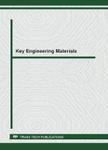版权所有:内蒙古大学图书馆 技术提供:维普资讯• 智图
内蒙古自治区呼和浩特市赛罕区大学西街235号 邮编: 010021

作者机构:AECC Key Laboratory of Aeronautical Materials Testing and Evaluation Science and Technology on Advanced High Temperature Structural Materials Laboratory Beijing Key Laboratory of Aeronautical Materials Testing and Evaluation Beijing Institute of Aeronautical Materials Beijing100095 China
出 版 物:《Key Engineering Materials》 (Key Eng Mat)
年 卷 期:2019年第795卷
页 面:208-214页
核心收录:
学科分类:0806[工学-冶金工程] 0817[工学-化学工程与技术] 08[工学] 0805[工学-材料科学与工程(可授工学、理学学位)] 0703[理学-化学] 0822[工学-轻工技术与工程]
主 题:Scanning electron microscopy
摘 要:Addictive manufacturing (AM) allows for the layer-by-layer fabrication of components via sequential material deposition and it is of immediate interest in many applications, in particularly aviation field. This work is tackling the issue that the influence of the inner-defects and building orientations on the fatigue behavior of Ti-6Al-4V Alloys produced by Selective Laser Melting (SLM). Specimens were built in two orientations (horizontal and vertical to the substrate) in order to evaluate the impact of the induced anisotropy of fatigue properties. A series of fatigue tests at stress ratio R=-1 are conducted at 400°C. Scanning Electron Microscopy (SEM) is used to examine the fracture surfaces of fatigue specimens to qualify the failure mechanism and crack initiation sites, which are most likely attached to the surface defects. The fracture surface analysis of HCF specimen tested that most of the crack initiates from the defect under subsurface. The results of this study imply that the fatigue properties at 400℃ are highly dependent on the specimen orientations relative to build directions, as the defects close to surface are the mainly cause of the crack initiations. © 2019 Trans Tech Publications Ltd, Switzerland.